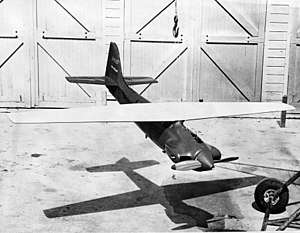Radioplane OQ-17
The Radioplane OQ-17 was a target drone produced by the Radioplane Company for the United States Army Air Forces and, as the TD4D/KDR Quail, the United States Navy. Suffering from an unreliable engine, the OQ-17 production run was cut short in favor of the OQ-19.
| OQ-17 KDD Quail | |
|---|---|
 | |
| Role | Target drone |
| National origin | United States |
| Manufacturer | Radioplane Company |
| Designer | Reginald Denny |
| Primary users | United States Army Air Forces United States Navy |
| Number built | 430 |
| Developed into | Radioplane OQ-19 |
Design and development
As the end of World War II approached, the U.S. Army Air Forces issued a requirement for a new target drone to replace the Radioplane OQ-2 family of drones, with higher performance to better simulate the improved capabilities of combat aircraft.[1] The RP-18, designed by Radioplane's Reginald Denny in response,[2] was of all-metal construction, with a high-mounted wing and conventional empennage. Power was supplied by a Righter O-45 four-cylinder horizontially-opposed engine, and launch was via catapult.[1] Control was maintained through conventional radio control, while if the drone was not shot down by the gunners using it for training, it could be recovered via an onboard parachute.[3] It was claimed that the OQ-17 could perform any maneuver that an ordinary fighter aircraft could.[3]
Operational history
Evaluation of the RP-18 began in March 1945; following trials, the U.S. Army Air Forces ordered the drone into production in February 1946, designating it OQ-17. The U.S. Navy also ordered the drone; it had been evaluated as the XTD4D-1, but before entering service the production TD4D-1 was given the new designation of KDR-1 Quail.[1]
Production of the OQ-17 and KDR was terminated after 430 aircraft had been completed, as persistent reliability issues with the O-45 engine could not be overcome; the Radioplane OQ-19 was ordered as a replacement.[1]
Variants and operators
- RP-18 - Original prototype version.[1]
- XOQ-17 - U.S. Army Air Forces (USAAF) designation for testbed RP-18s.[1]
- OQ-17 - USAAF; production version of XOQ-17.[1]
- XTD4D-1 - U.S. Navy (USN) designation for testbed RP-18s.[1]
- TD4D-1 - USN; original designation for production version of XTD4D-1[1]
- KDR-1 - USN; definitive designation for production version of XTD4D-1.[1]
- KDR-2 - USN; KDR-1 with structural improvements.[1]
Specifications
Data from Parsch 2003[1]
General characteristics
- Crew: 0
- Length: 8 ft 4.9 in (2.563 m)
- Wingspan: 10 ft 2 in (3.10 m)
- Gross weight: 143 lb (65 kg)
- Powerplant: 1 × Righter O-45-35 , 35 hp (26 kW)
Performance
- Maximum speed: 190 mph (310 km/h, 170 kn)
- Endurance: 60 minutes
- Service ceiling: 15,000 ft (4,600 m)
See also
Related development
Aircraft of comparable role, configuration and era
- Radioplane OQ-14
- Frankfort OQ-16
Related lists
References
- Citations
- Parsch 2003
- Newcome 2004, p.58.
- Astro-Jet #18, p.12.
- Bibliography
- "Navy Guided Missiles". Astro-Jet. Reaction Research Society (18). Fall 1947. Retrieved 2017-12-06.
- Newcome, Lawrence R. (2004). Unmanned Aviation: A Brief History of Unmanned Aerial Vehicles. Reston, Virginia: American Institute of Aeronautics and Astronautics. ISBN 978-1-56347-644-0.
- Parsch, Andreas (21 March 2003). "Radioplane OQ-17/TD4D/KDR". Directory of U.S. Military Rockets and Missiles, Appendix 1: Early Missiles and Drones. Designation-Systems. Retrieved 2017-12-07.